“One of the original downtown Rock Hill lots and early commercial sites – Finley and Minges.”
The Rock Hill Herald reported on Feb. 4, 1916 – “A number of improvements are being made to the rooms occupied by the chamber of commerce. Walls are being removed and the entire interior is being repainted. The Chamber took over the quarters of the Commercial Club. Pride Ratterree is in charge of these improvements.”
City Directories and History: 1908 – Ratterree Building, J.L. Bird (Bird’s Rugs and Carpets), Commercial Club, 100.5 – Southern Railway Offices, Supt RH Div. So Ry, Spencer and Dunlap, #102 – E.D. Belton, barber, 1922/23 – Quality Tonsorial Parlor @100, J.S. Starr – Reg. Architect, Thackston Studio – Photographer, Carolina Life Insurance, YMCA, S.C. Weston – tailor, Newton Snader – Cigar Maker, 1936 – Jerome Hardware @100 E. Main St.,
The Yorkville Enquirer reported on Oct. 31, 1878 – “The new store of Roach and Ratterree has been completed. The front has an unusual elegant appearance with bronze green trimmed by gold bronze.”
The Rock Hill Herald on Oct. 1, 1885 reported – “Mr. John Ratteree has determined to erect a two story brick building on the vacant lot between the PO and the store of Ms. Octavia Owens.”
The Herald on Sept. 30, 1886 reported – “Last Sunday morning a fire broke out in the livery stable of Mr. John Ratterree. The building was soon ingulfed in flames and the roof fell in. Three horses were killed and several buggies burned. A small tenement house was also burned. Mr. Ratterree places the loss at about $2,500.”
At 1:05 in the morning of March 24, 1887 a fire broke out on Main Street. At 2:00 a.m. the flames leaped into the Globe Hotel and the Frew Building. It didn’t take long for all of the buildings and warehouses on the west side of Main Street to go up in flames. The post office was torn down in an effort to block the fire’s path which would have destroyed the town library. – Louise Pettus
The Rock Hill Herald reported on Jan. 6, 1900 – “The Oldest landmark in our city has been torn down. We refer to the old Ratteree house on the corner of Main and Depot Streets. It was erected in 1837 by Mr. Bill Neely who lived there until 1844, when Mr. John Ratterree brought the place and moved his family there. This is before the Railroad came and before Rock Hill was established. We believe Mr. Bob Henry is the only citizen of Rock Hill living here when Mr. Ratterree made this his home. The timbers removed from the old home are in a good state of preservation. It has been torn down to make room for a new brick building to be erected by Gus and Pride Ratterree. As of Feb. 7, architect H.E. White has the plan for the Ratteree Office and Store building, to be erected at the corner of Main and Depot Streets ready for inspection. The first floor will be divided into three store rooms and the second floor will have sixteen rooms for office.”
The Rock Hill Herald reported on Aug. 25, 1900 – “The oldest home in Rock Hill, known as the Neely house, was destroyed by fire. For the past forty or fifty years, it belonged to the White Estate.”
The Rock Hill Herald reported on Feb. 7, 1903 – “J. Edgar Poag is expanding his real estate business. He has rented a large storeroom in the Ratterree Building recently vacated by J.H. Milling and Co., to use as a real estate and auction room.”
The Herald reported on Feb. 12, 1922 – “A.E. Ratteree and Pride Ratteree are renovating their store room on East Main Street presently occupied by Kirk and Roach and they are opening a drug store. A.E. Rattereee is an experienced druggist.”
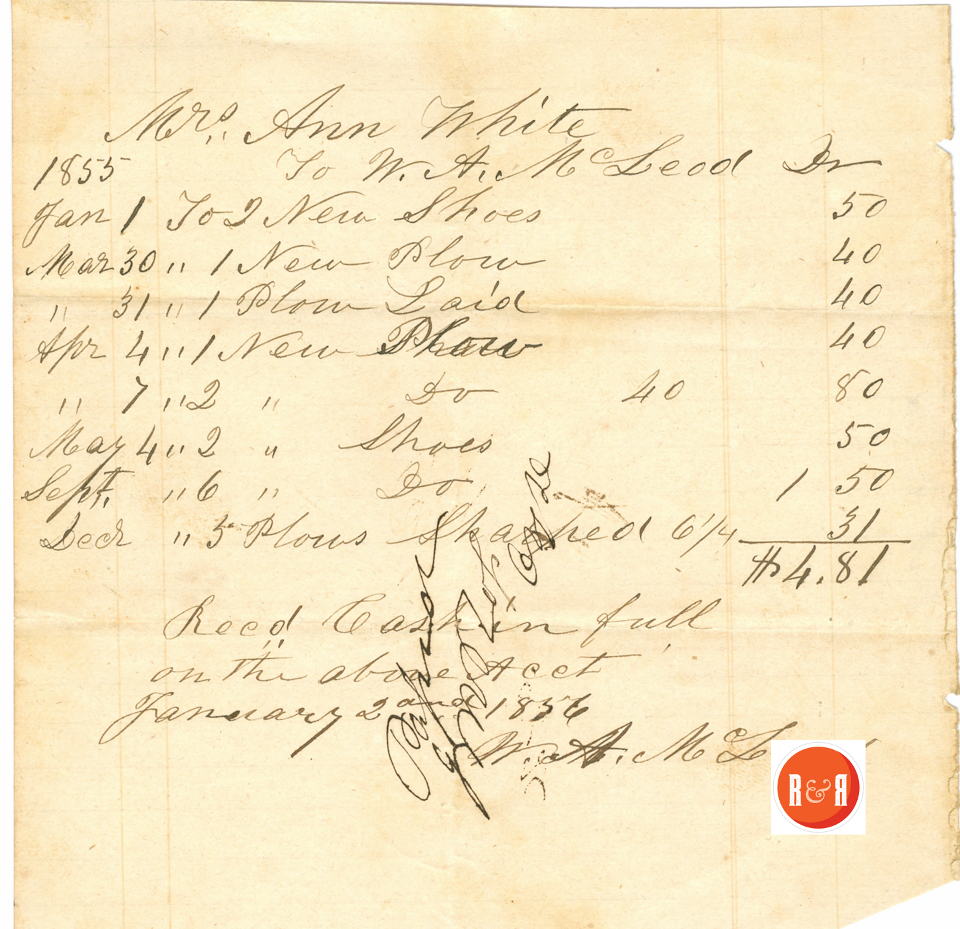
Bill for work by W.A. McLeod for Ann H. White in 1855 – Courtesy of the White Collection/HRH 2008
Ratterree Portion of Scrap B—When ‘Squire John Roddey was surveying Main Street in 1851, he laid off at the extreme southwestern corner of the A. T. Black tract a piece of ground which he
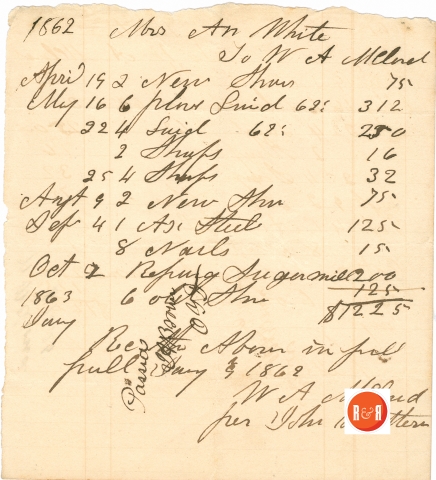
Receipt for services by W.A. McLeod of Rock Hill, S.C. in 1862 paid for by John Ratterree on behalf of Mrs. Ann H. White. Courtesy of the White Family Collection – 2008
divided into two parts and designated: Scrap B.” The Ratterree rectangular lot was the southwestern portion of “Scrap B.” A.T. Black sold this lot—68 feet wide and 212 feet deep—on December 24, 1852, to James Finley and John G. Minges for $100. The deed mentioned that a store house had already been erected on the property and was occupied by Finley and Minges as a tavern (barroom) and grocery. This frame structure stood on the corner of Main and Trade streets (Trade was formerly called Depot Street and then Railroad Avenue) from 1852 until 1895.
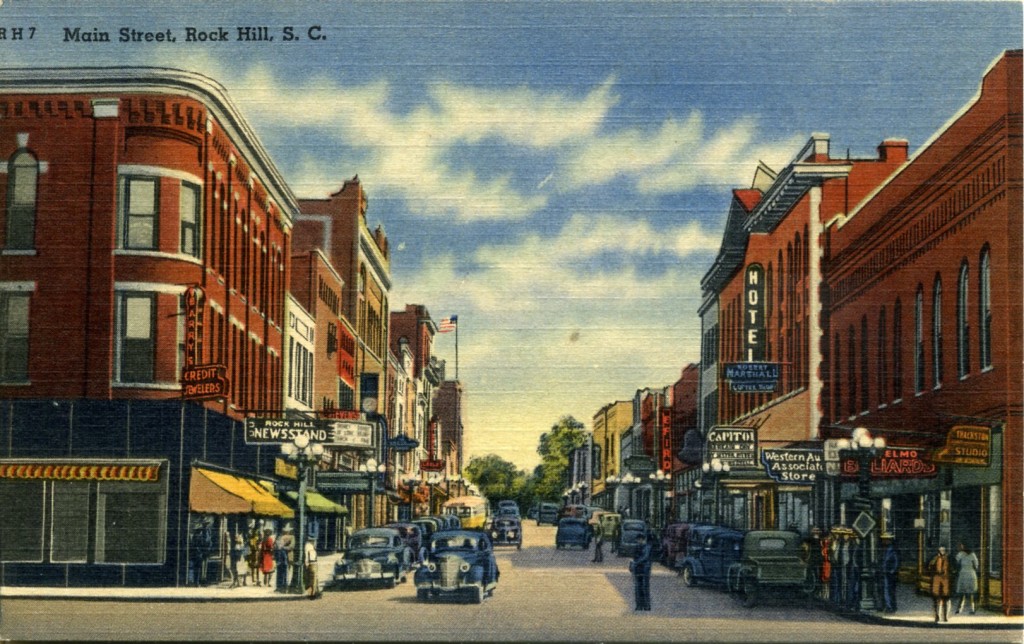
The ca. 1940 postcard shows the location of the handsome Ratterree Building on the corner of South Trade and East Main, on the right. Courtesy of the Turner Postcard Collection – 2012

Ad from the 1936 RH City Directory
There is hard evidence of the history of the aforementioned structure (hardly more that a shack in its original form) covering the years from 1852 to 1895, but the writer suggests that there is more here than meets the eye. The Reverend James Spratt White, writing in 1884, said that the little building in question was built by Captain J. H. McGinnis and operated by him about the time of the coming railroad. It is too bad that Mr. White did not elaborate on his simple statement. Another source says that the building was moved from Ebenezerville, where it had been used for some years by Brem and Orr, merchants of Charlotte, N. C.
Historian Wm. B. White, Jr. wrote, second to come and set up business in the town was Captain J. H. McGinnis, who shares the honor of being one of the first three merchants in Rock Hill. Joseph Harvey McGinnis was born in Mecklenburg County, North Carolina, probably in the city of Charlotte, c. 1823. He was educated in North Carolina and kept a store and farmed there. In the late 1840’s he removed to a farm which he had purchased in the Indian Land of York District, near the village of Ebenezerville. It is possible that the store was a South Carolina branch of the well-known Charlotte mercantile firm of Brem & Orr. (Along the Landsford Road, by Wm. B. White, Jr. Vol., I – 2008)
We know that the first depot at Rock Hill (really a warehouse) was erected long before the tracks were laid through what became the village of Rock Hill. The writer feels that some enterprising soul (perhaps Captain J. H. McGinnis) sensing a growing market at that place, leased from A. T. Black the lot at the southeast corner of Main Street and Depot Street (“the Ratterree corner”) c. 1851 and built thereon a modest store house, which for a year or more became a commissary for the men who inhabited the railroad camps nearby.
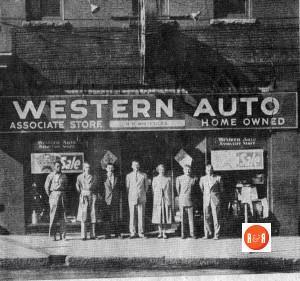
The Western Auto store was on Main Street.
It is likely that a business in operation in Ebenezerville about 1851, (probably conducted by Captain McGinnis) was moved to the projected village near the railroad depot. In other words, an Ebenezerville business was moved to Rock Hill, but not the building itself. When the rail line was completed to the Rock Hill depot, there was also laid a sidetrack (called a “turn-out” in those days) between the main line and the depot structure. As the track crews neared Rock Hill in 1851 and 1852, there was much coming and going in the vicinity of the depot and the well-known “rocky hill” that inspired the name of the depot. Boxcars loaded with all kinds of railroad equipment were “parked” on the new sidetrack, within easy reach of the workers. The writer is quite sure that the first inhabitants of what became the little village of Rock Hill were the workers employed in laying the tracks and stabilizing the roadbed against the day when the train would arrive.
The Yorkville “establishment” in the 1850’s was wont to describe the eastern part of York District as “the dark place in the District,” where gambling, drinking, and fighting were commonplace. The writer suggests that life in the railroad construction camps in and near the future village of Rock Hill probably gave rise to Yorkville’s oft-expressed contempt for the lifestyle of the blue collar workers within the Indian Land. Talk about humble beginnings….!
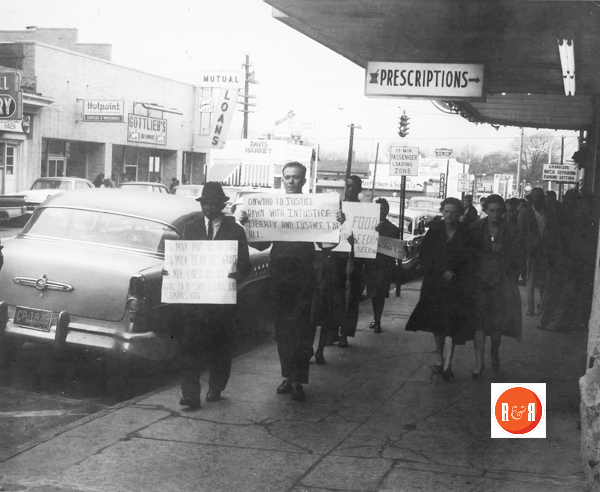
Courtesy of the Deas – Aiton Collection – Note the Ratterree building in the rear of the 1960s image.
Sometime during 1854 Rock Hill’s first murder was committed either in the back room of this store on the street in front of the building. It appears that James Vickers and his brother, Newton, came from Yorkville to the infant village of Rock Hill for the express purpose of killing a man named Dobson, a shoemaker whose shop was probably located in the back room of the little building. It is said that all three of the men were drunk and the Vickers brothers perpetrated their crime while under the influence of strong drink. At their trial at Yorkville Colonel T. N. Dawkins, the solicitor (prosecutor), won a guilty verdict from the jury. Judge J. Belton O’Neall sentenced the brothers to be hanged at Yorkville on December 29, 1854. Somehow Newton Vickers escaped the hangman’s noose. After he was sent to the penitentiary, his sentence was reprieved by the Governor of South Carolina. Vickers disappeared shortly thereafter. One source says he died in the service of the Confederacy; another says that he was never heard from again.
On May 11, 1854, James Finley signed over his interest in the modest business to his partner, Minges. Then, within four months, Minges died intestate, leaving as his heirs his wife, Rebecca E. Minges, and his brothers and sisters. By court order the property was put up for sale to effect a settlement. On February 6, 1855, William H. Neely (perhaps a business partner) purchased the lot from the Minges heirs. He continued to operate the business, but he went further. He erected on the back of the lot his residence, a two-story frame building which faced Depot Street, not Main Street. (It should be noted that the back of the lot was at a considerably higher elevation than the front. In fact, the back of the lot was the summit of a hill which stretched out north and west from the house site.)
John G. Minges was born in North Carolina on June 18, 1828, and died at Rock Hill on August 5, 1854. His remains were interred in Ebenezer Presbyterian Churchyard near Rock Hill.
William H. Neely and his family lived in this house for several years, but in December, 1858, he rented the house and several outbuildings to one E. Baugus, who, beginning on January 1, 1859, was operating there “The Rock Hill Hotel.” By June 1, 1860, Colonel Lucien P. Sadler, formerly of Yorkville, was in the hotel business in the same building. Evidently Mr. Baugus had moved away from Rock Hill. In one of his newspaper advertisements Colonel Sadler announced that there was a livery stable in operation on his hotel property. The proximity of the Neely house to the railroad line made it valuable as a site for lodgers.
Several years later, during the middle of the Civil War, John Ratterree and his wife, Martha Workman Rattarree, with their children, moved to the village of Rock Hill, which had become an important place for troop transfers and the storing of war supplies (away from the scenes of battle). On September 12, 1863, for $1600, John Ratterree bought the Neely property. This southeast corner of Main Street and Depot Street was known for the next hundred years as “the Ratterree corner.” Ratterree and his family occupied the residence and he at once entered into the business life of Rock Hill. He was successful, acquiring wealth and political power. One writer has called him “the political lord of the community” during the years from 1866 to 1890.
It is likely that, in the 1870’s and 1880’s, other frame buildings stood on the front of the lot, next to the old frame store building. Certain it is that John Ratterree had his smokehouse, his barn, a large stable, and several other outbuildings on the back of the lot, behind the house. He later acquired the triangular lot just to the west of his original lot. This triangle faced Depot Street on the long side and Church Street (now Black Street) on the short side.
The little original building continued in use. For a number of years Miss Octavia Owens rented the structure and conducted a thriving grocery business there. She died in 1889. On Tuesday morning, January 8, 1895, the historic store building fell victim to the flames. At that time it was occupied by J. H. Kerr as a meat market. The basement was being used by Sam Lisney as a shoe shop. (One writer has said that the building had another wing in the 1880’s, used as an eating place, and that this portion was torn down in 1887 to arrest the progress of the disastrous fire which destroyed most of the business on the south side of Main Street.)
John Ratterree, after the fire of 1895, put up several small frame buildings on Main Street for temporary use as store rooms. Then in the early part of 1900 the family decided to erect a large (75 by 100 feet) brick office and store building. The first floor was to have three store rooms and the second floor sixteen rooms for offices. The architect was Hugh E. White. A. E. Ratterree and Pride Ratterree, sons of John and Martha, had the old residence razed to make room for their new building. When the brick structure was begun, the frame buildings erected after the 1895 fire were rolled down to the Ratterree property on Depot Street. The brick building was used continuously from 1900 until it was destroyed in a spectacular, $200,000 fire on the night of October 12-13, 1953. Ratterree Drug Company was then occupying the structure, together with several other establishments.
On Jan. 8, 1896 the Herald reported – “that Jim Hall has opened up his barber shop in the Ratterree Building on the corner of Main and Railroad Streets.”
On Feb. 5, 1896 the Herald reported – “A new room has been added to the Ratterree Building for use of Woods’ Cotton Exchange.”
The Herald reported on Sept. 26, 1896 – “Mr. John Ratterree is having the little shanty on the corner of Main and Railroad Streets moving back about thirty feet. He will put in its place a store to be used as a beef market. A handsome brick block would add greatly to the looks of the town.” On Sept. 30, 1896 – “Mr. W. M. Steele will open a green grocery and meat market in the new Ratterree building on Main Street. “
The Herald reported on Nov. 25, 1896 – “That the Rock Hill Library (see further information in the Early History of Rock Hill link) was established by Rev. James S. White in 1884. It now has over 700 volumes, public documents, and the best periodicals. Some books were damaged by a fire a year or so ago. Ms. Ema Perrin is librarian.”
Downtown Rock Hill, ca. 1918 – Courtesy of the WU Pettus Archives – 2024
The Rock Hill Record reported on March 31, 1900 – “Fire on Wednesday evening destroyed the barn of the Ratterree’s and they lost a stock of harnesses and implements. A small building on the property of the Carolina Hotel was also lost.”
The RH Herald reported on June 6, 1900 – “Work on the new Ratterree Building has been delayed by rain. The pressed brick for the front will be obtained from Baltimore.”
The Herald reported on Aug. 18, 1900 – “Mr. A. Moses has left for the northern markets where he will buy a complete stock of dry goods, notions, etc. He will occupy one of the handsome store rooms in the Ratterree Building.”
The Herald reported on Sept. 15, 1900 – “W.M. Steele and Co., will move into the corner store of the new Ratteree Building on Monday.” (The Herald reported on Oct. 6, 1900 – “Mr. George Beach has moved his jewelry establishment to the store in the Ratterree Block occupied by W.M. Steele and Co.,)
On April 9, 1902 the Herald reported, “Mr. Eugene M. Holler has decided to remain in Rock Hill and has opened a real estate and rental agency in the Ratterree Building.”
The Record reported on Jan,. 7, 1907 – “The headquarters for the new Rock Hill Division of the Southern Railroad will be located in the Ratterree Building. The Supt. of the Div. is J.H. Herne. ”
The Rock Hill Record on Feb. 8, 1907 reported that Rock Hill is paving sidewalks on Main Street. Specifications for the cement paving were drawn up by architect (Hugh E.) White.
The Rock Hill Record reported on July 23, 1908 – “Wednesday morning there was a fire at the Ratterree Building. It burned before the fire dept. got there and damaged the following businesses: Bird’s Furniture Store, Ed Benton’s Barber Shop, J.E. Poag’s Real Estate Office, (all on first floor), and the Commercial Club and Spencer and Dunlap Law Offices and an annex of the Carolina Hotel (second floor.)
The Record reported on Aug. 20, 1908 – “The work of repairing the interior of J.l. Bird’s Furniture Store is progressing rapidly and he should open for business this week.”
The Rock Hill Record reported on Dec. 31, 1908 – “Mr. (Wm. W. Smythe), who has been in charge of the meat department of the Green Grocery, has left and will open a market at the Aragon Mills. On Jan. 18th we learn Mr. Smythe has reconsidered and instead of opening a market at the Aragon Mills he has opened a market in the rear of Weeks Grocery on Railroad Avenue.”
The RH Record reported on Feb. 15, 1909 – “Mr. T.A. Crawford, Jr. has sold his grocery business to C.D. Cunningham and Mr. Crawford now has an office in the Ratterree Building, selling real estate, stocks and bonds.”
The Rock Hill Record reported on April 26, 1909 – “The Poag Real Estate Company will in the near future have streets graded through the Cox property, northwest of Winthrop College. This property has already been surveyed into lots and small farms, making fine building sites for African American citizens, and the small farms are good for truck farming.”
The RH Record reported on April 29, 1909 – “Mr. S. Daghir, a Syrian who has been operating a store in Lancaster, arrived in Rock Hill yesterday and is repairing the storeroom formerly occupied by Weeks Grocery and will open a drygoods store to be known as S. Daghir and Company.”
The Herald reported on Jan. 1, 1910 – “There was a fire at the Ratterree Building on Saturday evening, which was the third firm in less than a year. The front wall was engaged but the fire department appeared quickly and little damage was done.”
The Rock Hill Record reported on Jan. 22, 1912 – “J.J. Keller and Co., have rented the storeroom now occupied by J.L. Bird’s Furniture Store, corner of East Main and Railroad Ave., (The 1908 Rock Hill City Directory listed J. Leonard Bird at 100 East Main Street).” (The Record reported on Jan. 3, 1907 – “M.F. Owens, grocery man, who has occupied a storeroom in the Ratterree Building for several years, moved his stock to a vacant store on Depot Street this week. The store vacated by Mr. Owens will be occupied at once by Mr. J.L. Bird, formerly of Kershaw who will engage in the furniture business. We will then have three furniture stores.)
The Record contained an ad on May 27, 1912 for J.J. Keller and Co., funeral directors and embalmers. The office and parlor is in the Ratterree Building on East Main Street in Birds Old Stand. J.J. Keller and John M. Anderson are principles.
The Rock Hill Herald on Dec. 10, 1918 reported on the opening of the Rock Hill Lodge, Loyal Order of Moose which occured on Dec. 9. They are located in the Ratterree Building in the office formerly occupied by the Chamber of Commerce.
The Herald on Oct. 17, 1968 contained a photograph showing: “the demolition of McDaniel’s Corner at Black and South Trade Streets, which contained a grocery – fish market and snack shop.”
In 1912 the Ratterree brothers put up a second handsome brick store building, on their triangular lot facing Depot Street. Julian S. Starr was architect. This building, along with the one which replaced the building burned in 1953 (facing Main Street), was taken down in 1972-73 as part of the Urban Renewal program.
But there is more to the story than this. It was the rocky knoll on whose summit the Ratterree residence stood which gave Rock Hill its name in 1851. J. Lawrence Moore and Colonel Edward Avery named the railroad depot for the hill through which railroad track crews had to blast a roadbed as they completed the line to Rock Hill. The hill was covered with innumerable boulders, which gradually disappeared through the years. The last boulder was crushed in April, 1905. In 1973, the grading machine obliterated the last vestiges of the old hill which gave Rock Hill its name. The Ratterree corner certainly played an important part in our history.
The early Ratterree building was attributed to Architect, Hugh Edward White (1869 – 1939), born in Fort Mill, S.C., he attended Fort Mill Academy and started his practice in about 1894. Remained in Rock Hill until about 1903 and later returned to work. In the 1890’s he worked in an architectural firm in Atlanta. Between 1903-1918 he was a field supervisor of the Supt. Architect Dept. of the Treasury. For about three years 1918-21, he was employed with Charles Coker Wilson in Columbia or Gastonia, N.C.
The Herald reported on Sept. 10, 1902 – “Mr. E.W. Mellon of Charlotte is in town to open a clothing store and has secured a store room from Mr. Pride Ratterree. Sept. 17, the stock of the Mellon Clothing Company has been received and will be opening soon.”
The Herald reported on April 22, 1903 – “Mr. Doby the barber, has rented the front part of the storeroom recently vacated by the Mellon Clothing Company and is having improvements made prior to opening a shop.”
The Rock Hill Record reported on April 12, 1904 – “That a contract has been let for installing two bathtubs in the Commercial Club to Mr. J.W. Westerluand. An automatic hot water heating apparatus will be attached.” In the 1908 RH Cit Directory the following officers were named: Walter M. Dunlap, Pres. M.F. Cobb, V.P., H.S. Diehl, V.P, C.L. Cobb, Sec.-Tre., and D.W. Creed, Manager.
The Record of Oct. 16, 1911 – “A land settlement has been reached between the Ratterree Estate and the Southern Railroad after twenty years of negotiation. Mr. Pride Ratterree will pay the railroad $2,750., for a portion of an acre on Railroad Ave. This will allow the straightening of the street and the construction of new buildings.” On Feb. 19, 1912, the Record reported, the business block to be erected on Railroad Ave., by Mr. Pride Ratterree will adjoin the Ratterree Building on the South and the two structures will be made as nearly harmonious as possible. To avoid leaving a vacant triangle between the two buildings, Mr. Ratterree will most likely enlarge the portion of the old building new used as a billiards room for the Commercial Club, something that has long been a need. Ratterree says, it is likely he will build a portico along the club side of the building.
The Herald reported on March 9, 1914 – “S.S. Plexico is today moving his stock from the Wilson Building to the storeroom formerly occupied by J.M. Taylor in the Ratterree Building.”
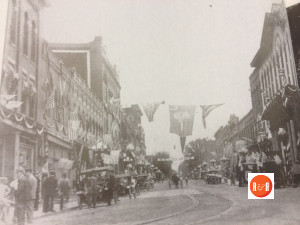
Early Rock Hill images within a short distance of the Ratterree Building. Images courtesy of the AFLLC Collection.
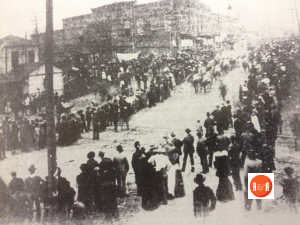
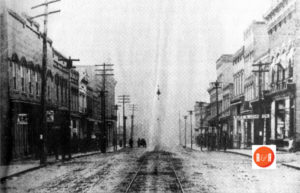
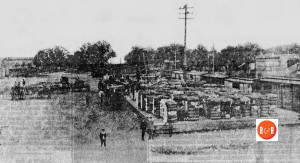
The Herald reported on Jan. 4, 1915 – “There was a fire at the Ratterree Building on Railroad Avenue, it began in the storeroom of S.S. Plexico. There was damage to the rear and some damage to walls, but it was soon extinguished. Directly over the Plexico Store is the Chamber of Commerce headquarters with the Library adjoining. The Commercial Club occupies the remainder of the second floor. The laundry of Jimmie C. Lee, a China-man was damaged by smoke. The store of Elias and Company is next to Plexico’s. Jan, 5th – the Library is open as usual and was not damaged by fire.”
The Herald (add) March 16, 1915 – “Contained and add for F.A. Barber, a photographer – located in the Ratterree Building in the room formerly occupied by the Business College.”
The Herald reported Jan. 30, 1919 – “That David R. Moore and W. Perry Gill have bought the interest of J. Thorn Neely in the Gill & Neely of this city. Mr. Moore, who was recently discharged, from the military service, was with this concern for sometime before going into the army. Perry Gill, who is now with the U.S. marines in Germany, is the son of W.W. Gill, one of the sons of the Gill & Neely grocery. Mr. Neely, for several years a member of this company, has not made public his intentions as to his future business connections.”
Note in the far right bottom corner, the frame building which remained on the Ratterree Lot even in ca. 1890s.
From the Rock Hill Record, April 8, 1912 – “Contractors Moser and Baumgarner of Hickory, N. C. have begun work on the new two-story brick building on Railroad avenue for Ratterree Bros. This building will contain 4 storerooms on the first floor and halls overhead.
Mr. J. S. Starr, architect, has drawn plans for the Messrs. Ratterree for another building between this one and the building on the corner of East Main and Railroad avenue, with a frontage of 76 feet on the latter street. The contract for this will be let shortly. When these buildings are completed they will add very much to the appearance of the street on which they are located, which has for a long number of years had only some unsightly tin shacks on it.
Mr. Starr has also drawn plans for a handsome two-story brick building for Mrs. D. Hutchison, to be erected on Railroad Avenue, between her present storerooms and the corner next to the passenger station of the Southern Railway, taking in the space between the Candy Kitchen and Davis’ Meat Market on that street. This building will contain three new storerooms and halls overhead suitable for offices and other purposes, and will also include putting a second story over the storeroom now occupied by the Candy Kitchen. The contract for this building, we are informed, will be let shortly and work will be commenced as soon as possible, and will add very much to the looks of the street, which contains a number of tin shacks which are eyesores to the city.
Mr. Starr has also drawn plans for residences for the following parties: a 9-room bungalow for Mr. B. L. Ivey; an 8-room house for Mr. W. E. Stowe; a 7-room house for Miss Julia Campbell of Black Mountain, N. C. to be erected here; and a 9-room house for Mrs. W. M. Steele on Marion Street.”
The Record reported on Jan. 17, 1927 – “Anti-Ferment Company, manufacturers of a well known medicine, are to move back to Rock Hill from Columbia. They will be on the second floor of the Ratterree Building, and have leases space formally occupied by the Chamber of Commerce. Clarence and Fletcher Kuykendall operate the plant. They are grandsons of Mrs. M.E. Ruff of Rock Hill and nephews of Ms. Cora Kuykendall.”
The Record reported on April 18, 1927 – “That John M. Simrill, recently associated with Rock Hill Supply Company as a salesman, has entered to grocery business. He is located on East White Street, next to Starnes Plumbing Company. He had worked previously for the Rock Hill Grocery Company and Gill and Moore Grocery Company.”
[Information provided via Along the Land’s Ford Road – Vol. I, 2008 by William B. White, Jr.]
Additionally, the Ratterree family later constructed a massive office complex along Trade Street and East Main. This was the work of local architect and builder, Mr. Julian S. Starr. The commercial building began in 1912 and cost $20,000.
History of the Rock Hill Post Office: This was an article in the Herald on May 29, 1931 provided as part of an advertisement for People’s National Bank, the information from Buena Wood due to the first day the Post Office was being operated on a temporary basis on Hampton Street as the new Federal Building (Gettys Center) was being constructed.
“The first P.O. in Rock Hill was on Trade Street, where the A&P Grocery store is now (1931), Mr. Ferguson was Post Master. The next site was on West Main Street, on the lot now occupied by Marshall Oil Company in 1931. The Post Mistress was Maria Rutland. The PO then moved to Ratterree’s Corner on the spot now occupied (1931) by Hood Clothing Company. Col. William Kerr was Post Master. The next site was on Main Street in a building adjacent to W.L. Roddey and Company. A fire destroyed this building and it was then moved to the Roddey Hotel. Miss Buena Wood was then Post Mistress. The PO then moved to one of Mr. Roddey’s storerooms now occupied by Rock Hill Hardware Company in 1931. Col. Cad J. Pride was the Post Master. The next site was on Main Street in the White Property, now partly occupied by the Merritt Shoe Company in 1931. The next Post Master was E.E. Poag. In 1906 the present PO on the corner of Main and Caldwell was built, following Mr. Poag, post master have been; V.B. McFadden, E.E. Poag and A.R. Barrett. Temporary quarters for the PO are now in the Barber – Sykes Building on Hampton Street opposite the City Hall.”
Buena Wood – Author
The J.N. McElwee Store had an account in 1915 – 16 for the Chamber of Commerce.
Stay Connected
Explore history, houses, and stories across S.C. Your membership provides you with updates on regional topics, information on historic research, preservation, and monthly feature articles. But remember R&R wants to hear from you and assist in preserving your own family genealogy and memorabilia.
Visit the Southern Queries – Forum to receive assistance in answering questions, discuss genealogy, and enjoy exploring preservation topics with other members. Also listed are several history and genealogical research.
User comments welcome – post at the bottom of this page.
Please enjoy this structure and all those listed in Roots and Recall. But remember each is private property. So view them from a distance or from a public area such as the sidewalk or public road.
Do you have information to share and preserve? Family, school, church, or other older photos and stories are welcome. Send them digitally through the “Share Your Story” link, so they too might be posted on Roots and Recall.
User comments always welcome - please post at the bottom of this page.
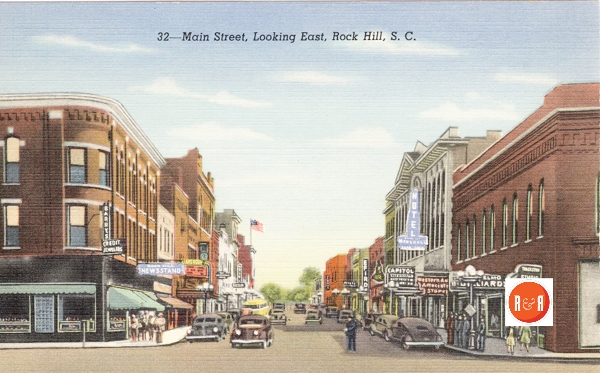

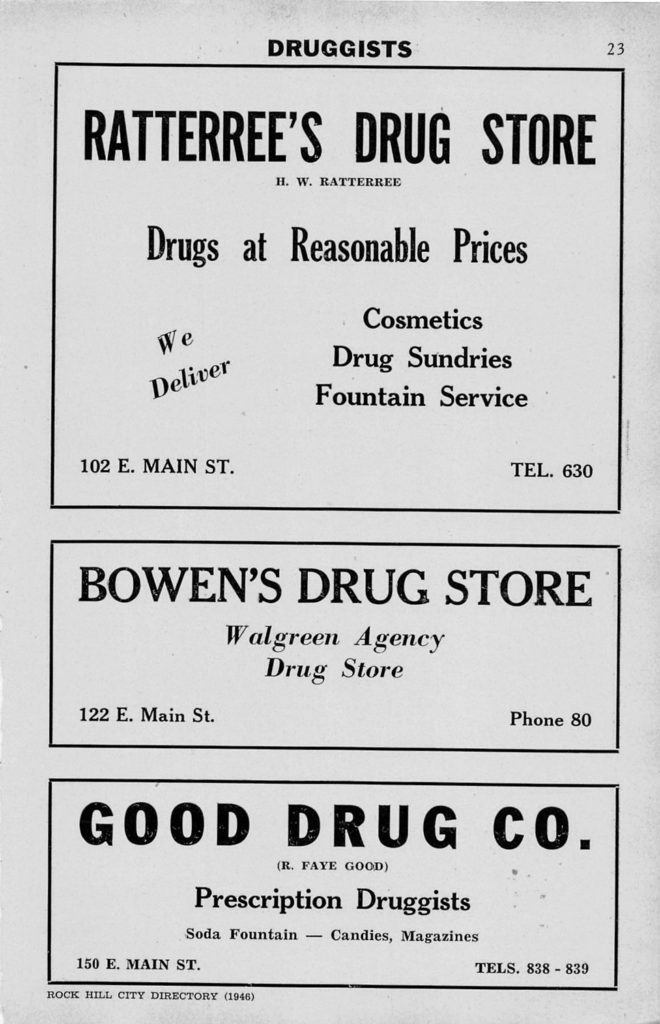
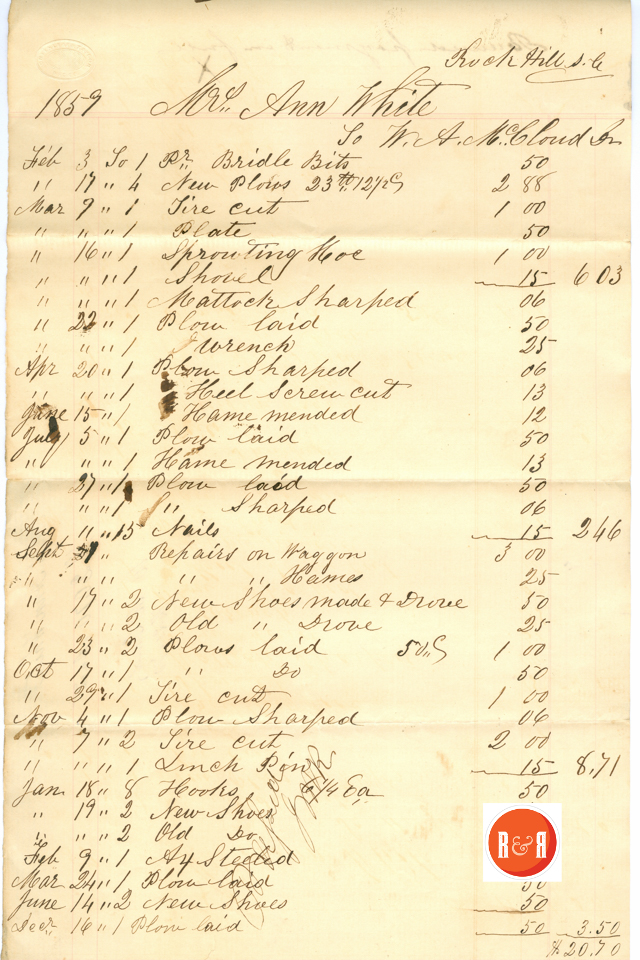
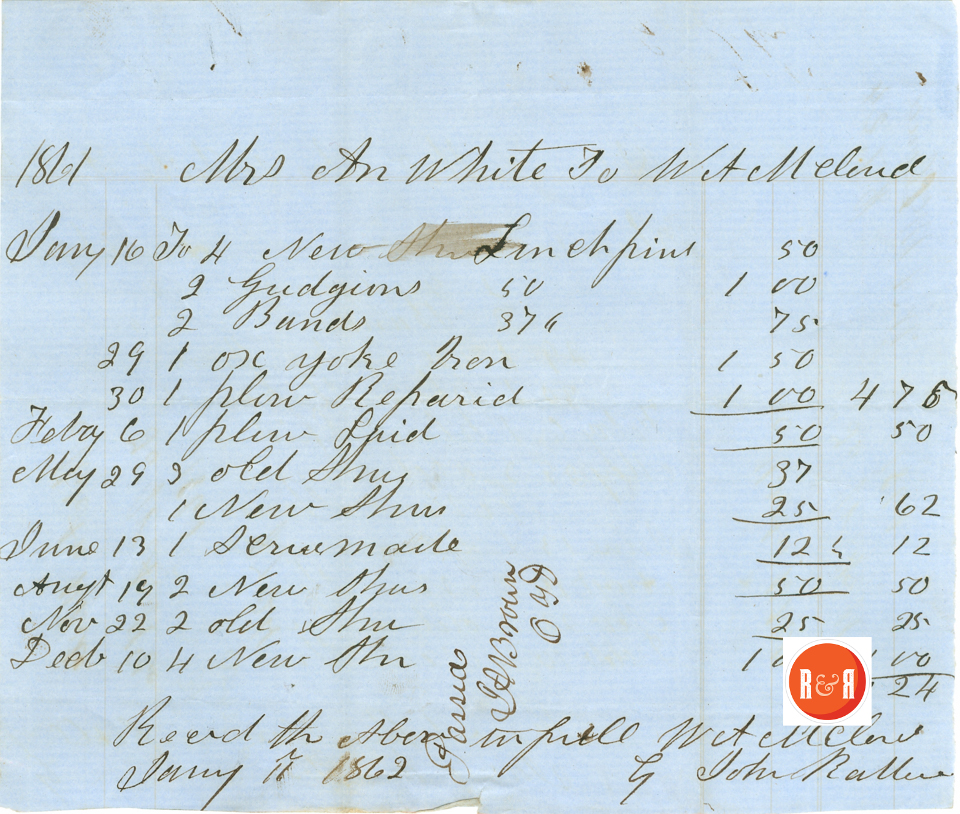
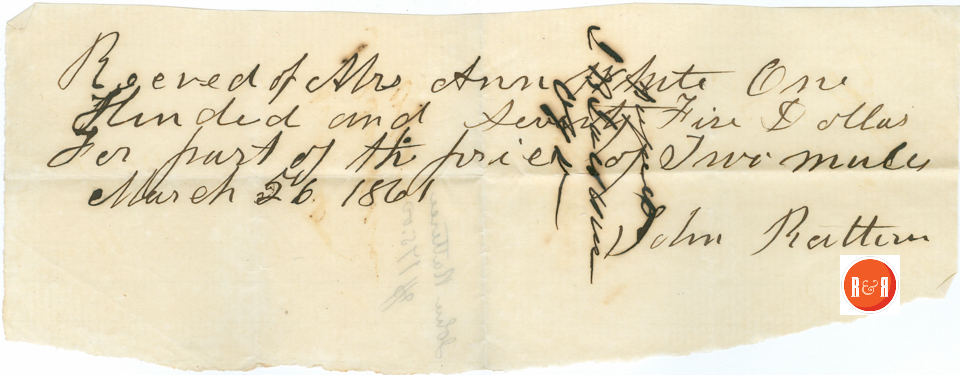
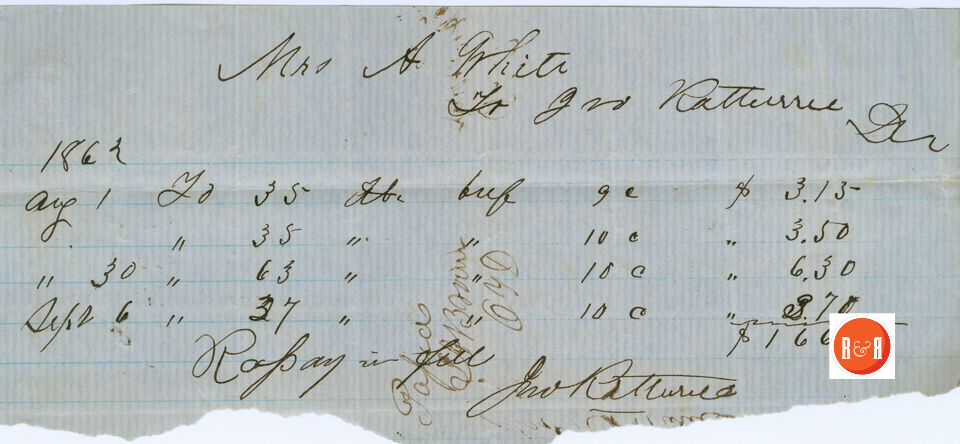
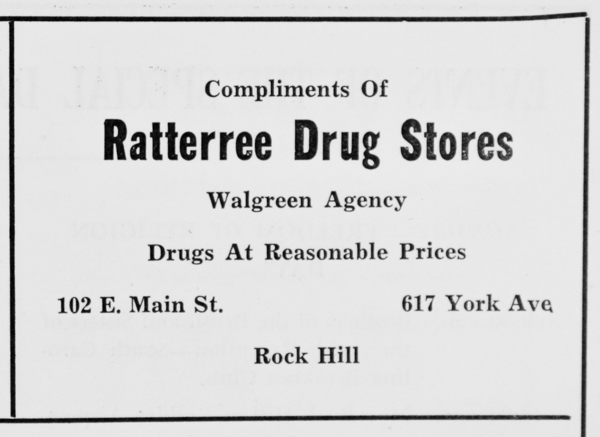
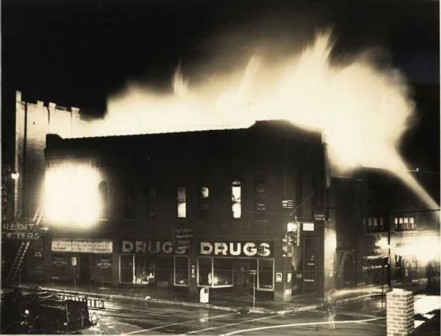
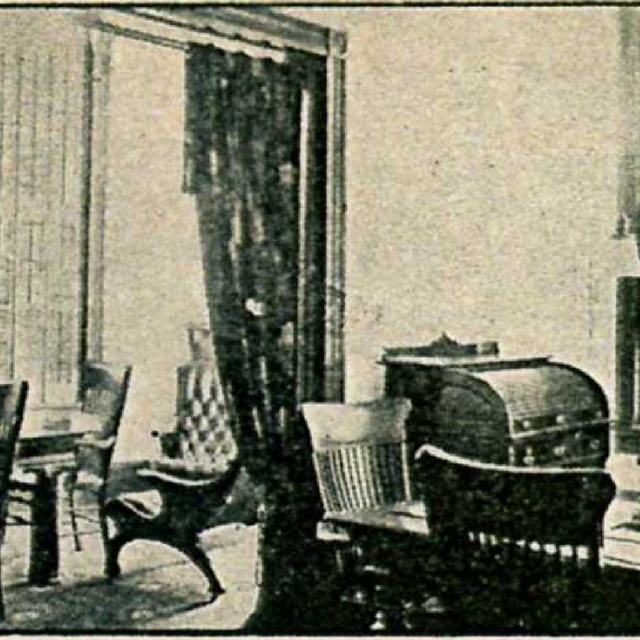
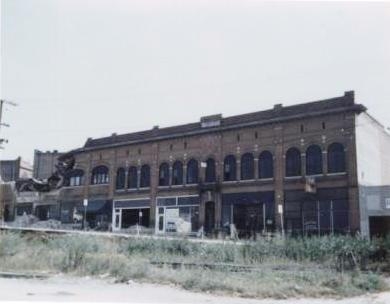
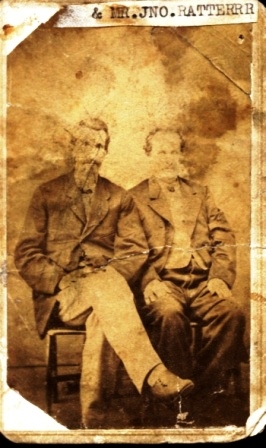
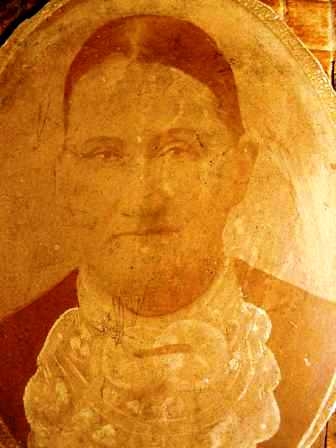
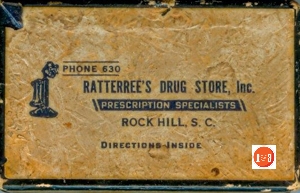
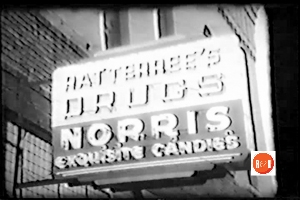
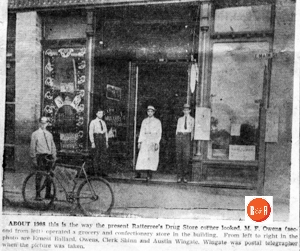
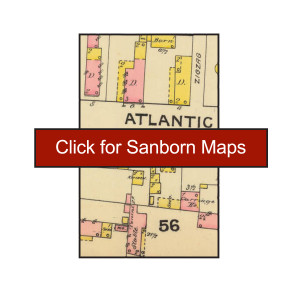
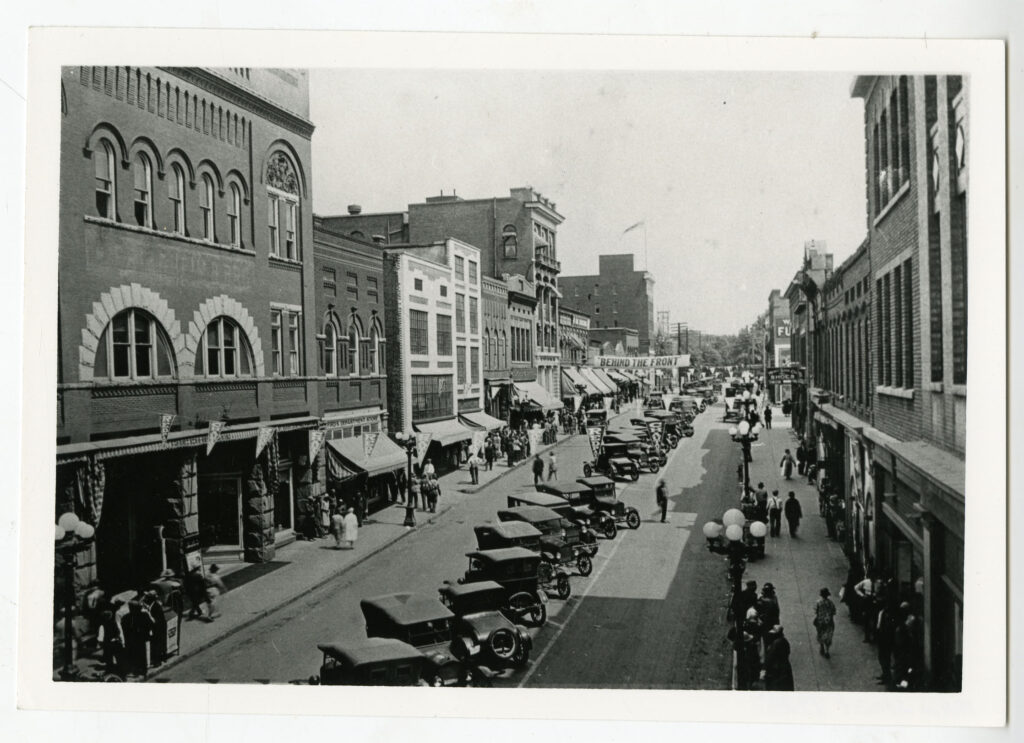
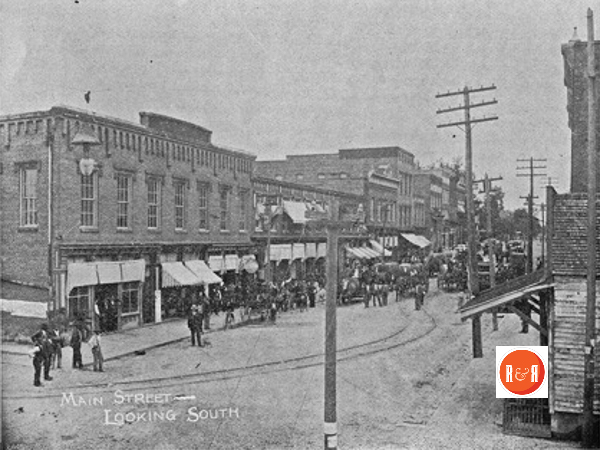




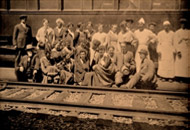
Share Your Comments & Feedback: